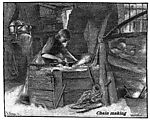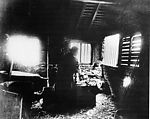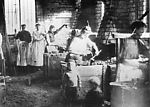“…wizened infants hanging to their mothers’ breasts, as these ply the hammer, or sprawling in the mire on the floor, amidst the showers of fiery sparks”. (Robert Sherard, 1896)
When reading the description of life in a domestic chain-shop, we find that children were often present. The sight of children working in chain-shops would be unacceptable today, but in the 19th and early 20th centuries, it was commonplace. Women had little choice but to keep their children with them if they were below school age, as to employ a child carer would have been unaffordable.
The domestic chain-shops were not subject to the Factory Acts and were rarely inspected by anybody in authority so what went on inside was known only to those in the industry. After school, the children could make themselves useful by blowing the bellows to provide the “blast”, or even cutting the rods to length and part-bending them. This may have earned them a little pocket money, as well as preparing them for working in the industry.
In 1889, the Reverend Harold Rylett produced his report on the conditions of the back yard chain-makers. The illustration by Tom Hill shows two children, one a baby in a cradle and the other a child of about five, sleeping whilst their mother works. Robert Sherard wrote, “From a pole which ran across the room there dangled a tiny swing chair for the baby, so that whilst working her hammers, the mother could rock the child”. Babies were often laid down on the bellows and rocked to sleep by the motion, as they produced the "blast" for the forge. The pivot that allowed the bellows to move became known as the "rock".
Rollover the captions in the box to see the available images in thumbnail format, click the caption to see the full-size image
| Reference: | 715 |
| Keywords: | |
| Archive Ref: | |
| Updated: | Mon 25 Jun 2007 - 0 |
| Interpretation written by | Louis Howe |
| Author's organisation | Curatorial |
| Organisation's website |



